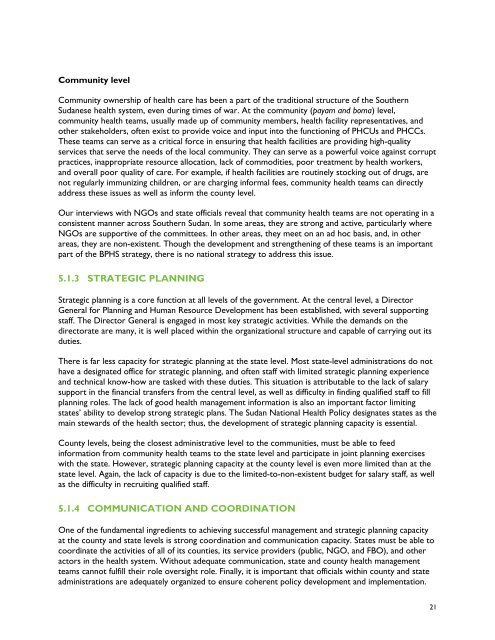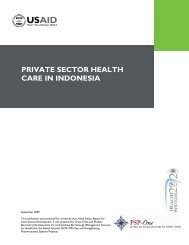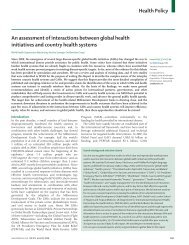southern sudan health system assessment - Health Systems 20/20
southern sudan health system assessment - Health Systems 20/20
southern sudan health system assessment - Health Systems 20/20
You also want an ePaper? Increase the reach of your titles
YUMPU automatically turns print PDFs into web optimized ePapers that Google loves.
Community level<br />
Community ownership of <strong>health</strong> care has been a part of the traditional structure of the Southern<br />
Sudanese <strong>health</strong> <strong>system</strong>, even during times of war. At the community (payam and boma) level,<br />
community <strong>health</strong> teams, usually made up of community members, <strong>health</strong> facility representatives, and<br />
other stakeholders, often exist to provide voice and input into the functioning of PHCUs and PHCCs.<br />
These teams can serve as a critical force in ensuring that <strong>health</strong> facilities are providing high-quality<br />
services that serve the needs of the local community. They can serve as a powerful voice against corrupt<br />
practices, inappropriate resource allocation, lack of commodities, poor treatment by <strong>health</strong> workers,<br />
and overall poor quality of care. For example, if <strong>health</strong> facilities are routinely stocking out of drugs, are<br />
not regularly immunizing children, or are charging informal fees, community <strong>health</strong> teams can directly<br />
address these issues as well as inform the county level.<br />
Our interviews with NGOs and state officials reveal that community <strong>health</strong> teams are not operating in a<br />
consistent manner across Southern Sudan. In some areas, they are strong and active, particularly where<br />
NGOs are supportive of the committees. In other areas, they meet on an ad hoc basis, and, in other<br />
areas, they are non-existent. Though the development and strengthening of these teams is an important<br />
part of the BPHS strategy, there is no national strategy to address this issue.<br />
5.1.3 STRATEGIC PLANNING<br />
Strategic planning is a core function at all levels of the government. At the central level, a Director<br />
General for Planning and Human Resource Development has been established, with several supporting<br />
staff. The Director General is engaged in most key strategic activities. While the demands on the<br />
directorate are many, it is well placed within the organizational structure and capable of carrying out its<br />
duties.<br />
There is far less capacity for strategic planning at the state level. Most state-level administrations do not<br />
have a designated office for strategic planning, and often staff with limited strategic planning experience<br />
and technical know-how are tasked with these duties. This situation is attributable to the lack of salary<br />
support in the financial transfers from the central level, as well as difficulty in finding qualified staff to fill<br />
planning roles. The lack of good <strong>health</strong> management information is also an important factor limiting<br />
states’ ability to develop strong strategic plans. The Sudan National <strong>Health</strong> Policy designates states as the<br />
main stewards of the <strong>health</strong> sector; thus, the development of strategic planning capacity is essential.<br />
County levels, being the closest administrative level to the communities, must be able to feed<br />
information from community <strong>health</strong> teams to the state level and participate in joint planning exercises<br />
with the state. However, strategic planning capacity at the county level is even more limited than at the<br />
state level. Again, the lack of capacity is due to the limited-to-non-existent budget for salary staff, as well<br />
as the difficulty in recruiting qualified staff.<br />
5.1.4 COMMUNICATION AND COORDINATION<br />
One of the fundamental ingredients to achieving successful management and strategic planning capacity<br />
at the county and state levels is strong coordination and communication capacity. States must be able to<br />
coordinate the activities of all of its counties, its service providers (public, NGO, and FBO), and other<br />
actors in the <strong>health</strong> <strong>system</strong>. Without adequate communication, state and county <strong>health</strong> management<br />
teams cannot fulfill their role oversight role. Finally, it is important that officials within county and state<br />
administrations are adequately organized to ensure coherent policy development and implementation.<br />
21
















